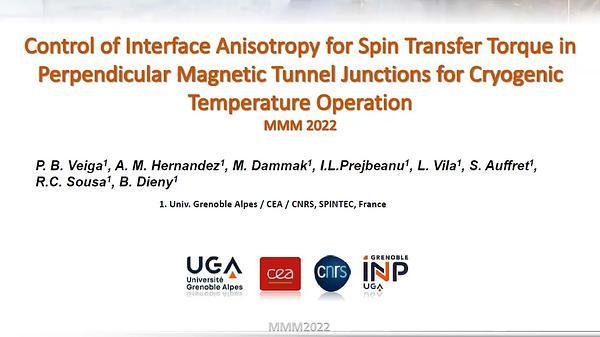Would you like to see your presentation here, made available to a global audience of researchers?
Add your own presentation or have us affordably record your next conference.
Magnetic random access memories (MRAM) store information on magnetization direction instead of electric charge. All optical switching (AOS) of a magnetic tunnel junction provides an efficient way to enable writing at speeds orders of magnitude faster than electrical alternatives based on spin torque methods, allowing for write operations at THz frequencies. The Tb/Co multilayer is particularly interesting, since its large perpendicular magnetic anisotropy would allow data retention at small sizes and could be integrated into a magnetic tunnel junction 1-2. This work reports magnetization reversal driven by femtosecond light pulses on a Tb/Co based perpendicular magnetic tunnel junction patterned to sub-100nm lateral dimensions. This optical switchable electrode was integrated into an MgO based MTJ having synthetic anti-ferrimagnet reference layer element, where the AOS magnetization direction can be read directly from the resistance state of the junction. The optically switchable electrodes are Tb/Cox5 multilayers coupled to a 1.4nm FeCoB layer through a 0.2nm W insertion layer. Patterned AOS-MTJ nanopillars fabricated with diameters down to 80 nm showed TMR ratios up to 74% and a resistance area product of 112 Ω μm2. Figure 1) shows the hysteresis loop for a Tb 0.6nm/ Co 1.4nmx5 multilayer. It was possible to observe a toggle switching between low and high resistance states, corresponding to parallel and anti-parallel alignment of the two electrodes, after each 50 fs long laser pulse applied on the device. A systematic study on the switching probability will be compared to existing results of AOS experiments on continuous films. There it was possible to demonstrate that reliable and robust toggle switching can be achieved for specific Tb and Co thickness in the range of 0.6-0.9 nm of Tb and 1.3-1.5 nm of Co. The magnetization reversal is reliable after a 150.000 pulse sequence. Single shot AOS is achievable using laser pulse durations from 50 fs up to 10 ps and fluences 3-6.5 mJ/cm2. These results pave the way towards an AOS ultra-fast and energy-efficient memory.
References
1 A. Olivier et al., Nanotechnology 31, 425302 (2020).
2 L. Avilés-Félix et al., Scientific Reports 10, 1 (2020).

Figure 1 a) AOS-MTJ stack illustration b) R-H loop in perpendicular field c) AOS field-free toggle switching between P and AP states.
